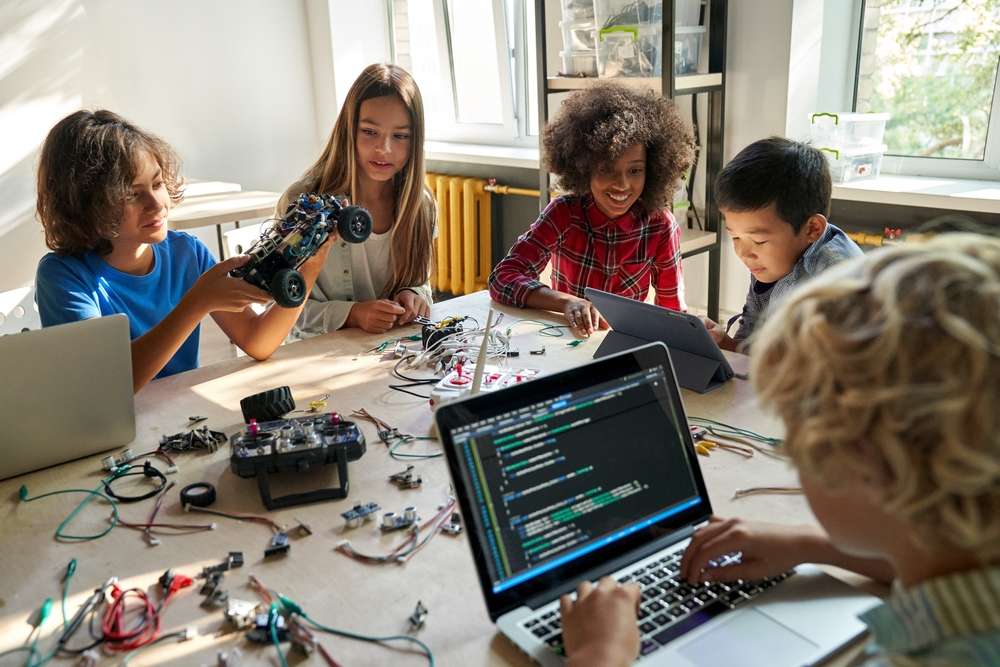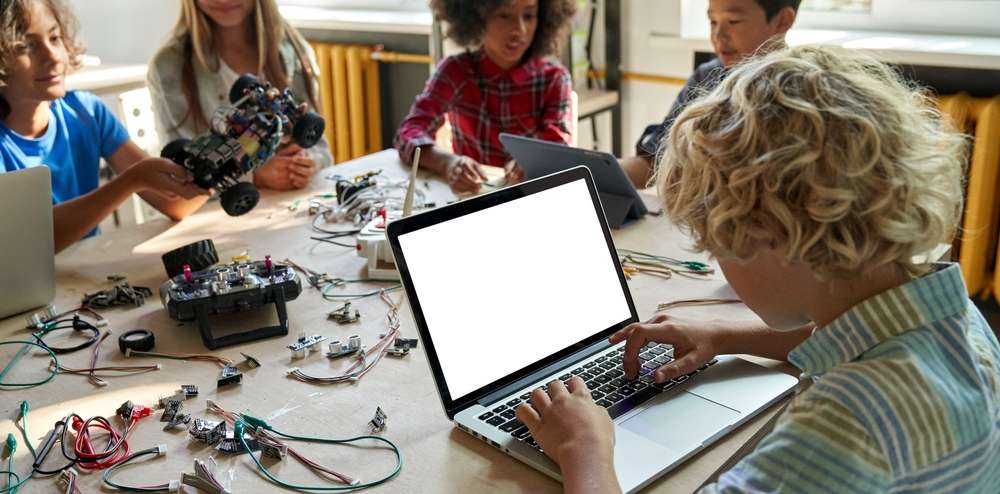
Understanding ChatGPT and its Potential in Adaptive Learning
ChatGPT is a state-of-the-art language processing Artificial Intelligence (AI) developed by OpenAI. As one of the most advanced examples of its kind, it employs machine learning techniques to produce human-like text, capable of carrying on a conversation, writing essays, and answering queries with an accuracy that has left many amazed. However, perhaps one of the most promising aspects is its potential in adaptive learning.
Adaptive learning, at its core, is about personalization in education. It’s tailored instruction that aims to meet individual learners at their level, engaging them in the right challenges at the right time, thereby maximizing their learning efficiency and effectiveness. The driving force behind adaptive learning is technology – digital platforms that can collect and analyze data in real-time to immediately adjust instruction to a learner’s needs.
This is where ChatGPT has a fundamental role to play. It can be leveraged to provide an additional layer of personalization and adaptivity in the educational space. Not just a tool for enabling conversation, ChatGPT has the potential to deliver personalized instruction, offer real-time feedback, and pose thoughtful questions to challenge students’ understanding – and all of this in a conversational, engaging manner.
By incorporating the principles of Natural Language Processing (NLP), the AI is able to understand and generate language in a way that resonates with students. It can recognize patterns, make connections, elaborate explanations, and generate queries – capabilities that are increasingly essential in an educational setting that values active engagement and personalized learning.
Moreover, the technology allows for continuous learning. While traditional adaptive learning systems may adjust after each lesson or unit, ChatGPT can adapt and respond instantly within a conversation. It allows for a truly dynamic learning environment that evolves organically based on the learner’s responses.
It’s also worth noting its scalability. While it can be a challenge to provide personalized instruction in a classroom setting due to logistical and time constraints, an AI-powered chatbot like ChatGPT doesn’t face these limitations. It can provide customized learning experiences to countless learners simultaneously, making it an invaluable tool in situations like online learning or massive open online courses (MOOCs).
However, incorporating ChatGPT into adaptive learning is not just about efficiency. Its human-like interactions can lead to more engaged and motivated learners. Students can learn at their pace, in their style, removing the pressure often associated with traditional educational environments. They can also have their queries addressed instantly, contributing to the construction of a more robust understanding of the subject matter.
Despite its immense potential, integration of ChatGPT doesn’t come without challenges. The AI’s reliance on the data it was trained on and the lack of an inherent sense of ethics or morality pose significant hurdles. However, with careful design, regular updates, and stringent control measures in place, these issues can be mitigated.
In conclusion, ChatGPT is not just a revolution in AI but could very well be a revolution in education. By merging this cutting-edge technology with educational techniques, we create a potent mix that has the ability to transform our learning experiences and outcomes. It’s an exciting time to be involved in education, and ChatGPT is undoubtedly a significant player to watch in this evolving landscape.

Exploring the Interface of AI and Education: An Introduction to Adaptive Learning
Artificial Intelligence (AI) is altering the way we interact, work, play, and learn, impacting various facets of daily life. Education, particularly, is one arena ripe for the transformative potential of AI. Comprehensive incorporation of AI in education brings forth an era of personalized, adaptive learning. As it becomes more intricate and sophisticated, AI opens up new avenues and possibilities for the educational landscape.
At the crossroads of AI and education, we encounter adaptive learning, a novel and dynamic approach that tailors education to individual learners’ unique needs and abilities. Unlike traditional linear learning methods that move all learners at the same pace, adaptive learning leverages AI to create a feedback loop of student data. This information is processed and analyzed to create personalized learning paths, thereby addressing each student’s distinctive strengths and weaknesses.
ChatGPT, an advanced language model developed by OpenAI, serves as an ideal example of AI’s possibilities within adaptive learning. It underpins how AI can revolutionize the teaching and learning dynamics. Through natural language processing capabilities, ChatGPT facilitates interaction that closely resembles a human teacher-student conversation. But beyond merely replicating human interaction, it allows a new level of personalization in education.
The capability of ChatGPT to understand and generate text makes it an excellent tool for generating adaptive content. For instance, if a learner struggles with a particular topic, the AI can introduce extra resources or revise the learning material’s presentation. It allows pacing through the curriculum at an individual’s speed, acknowledging the principle that education isn’t one-size-fits-all.
Adaptive learning can also address gaps in the current education system, such as standard assessments failing to capture unique learning styles and needs. AI-powered systems can provide a comprehensive view of a learner’s progression, identifying areas where they excel, where they falter, and even uncover hidden talents or interests.
However, adaptive learning isn’t just task-specific. Learning isn’t about task completion but understanding concepts and fostering critical thinking. With AI like ChatGPT, we can look beyond task-focused applications and delve deeper into notion comprehension. AI could facilitate interactive learning sessions, prompt students with challenging questions, and act as a sounding board for students to test their understanding, fostering deeper learning.
As we push forward with AI in education, caution is critical. Data privacy, fairness in AI algorithms, and ethical considerations are potent concerns. Furthermore, while AI can personalize learning paths, it cannot replace the human touch’s empathy, passion, and creativity. Thus, the idea isn’t to substitute teachers but to empower them, enhancing their teaching efficacy with data and insights.
In short, the interface of AI and Education is no longer a distant prognostication; it’s happening right now. By understanding and embracing the change, we can harness it for a more inclusive, personalized, and adaptive learning experience. As ChatGPT and other AI tools continue to advance, the educational frontier will expand, only limited by our willingness to adapt and progress.

Profound Impacts of ChatGPT on Personalized Learning Paths
The advent of powerful language processing models like ChatGPT heralds an era of unprecedented possibilities in the education industry, particularly in the sphere of personalized learning. Personalized learning paths represent a pedagogy approach aimed at designing learning experiences tailored to the unique needs, preferences and abilities of individual learners. A technology as adaptable and sophisticated as ChatGPT multiplies the avenues for implementing these customized approaches, so it’s worth exploring how.
The most direct impact of ChatGPT on personalized teaching is its capacity to create an environment that caters to each student’s pace and learning style. Unlike a fixed curriculum, ChatGPT can adjust the complexity and speed of instruction based on the learner’s responses. For example, if a student answers a question correctly, the AI can move on to more advanced topics. On the contrary, if the student experiences difficulties, it can revise previous material or even present the topic in a different way.
Secondly, ChatGPT opens up the opportunity for continuous learning. Traditional education models are limited by factors like school hours or teacher availability. In contrast, AI-powered bots, like ChatGPT, offer 24/7 availability, enabling learners to engage with their customized content at any hour that suits them.
Thirdly, ChatGPT makes learning significantly more interactive and engaging. Rather than simply presenting information, the AI engages learners through active dialogue. This boosts motivation levels and strengthens the learning outcomes.
Moreover, ChatGPT provides unparalleled access to instant formative assessment. It can evaluate the learner’s understanding as they progress through the learning materials, provide instant feedback, and constructively guide them about how to improve. This timely feedback empowers learners to take control of their learning process and fosters a growth mindset.
What sets ChatGPT further apart is its ability to foster meaningful, human-like conversation. Although still an AI, the nature of its interaction is warm and approachable, simulating a one-on-one tutorship model ideal for learners who may feel uncomfortable or anxious in a traditional learning environment.
Finally, ChatGPT can exploit big data mountain by drawing from a vast well of online resources and curating content to cater to a learner’s interest. For instance, if a student expresses interest in astronomy while studying physics, the AI can introduce related astronomical concepts, contributing to a more rounded, enjoyable, and engaged learning experience.
However, despite the numerous advantages of ChatGPT, it is important to acknowledge that AI in education is still a developing field, and potential challenges should be considered. Some concerns include the risk of decreased human interaction, data privacy issues, and the need for improved AI literacy among educators.
In conclusion, with all these significant merits, ChatGPT holds the potential to revolutionize personalized learning paths. As the technology continues to evolve and improve, we can expect even deeper customization and flexibility, marking a significant stride towards truly individualized education.

Case Study: Implementing ChatGPT in Lesson Planning and Adaptation
Chatbots empowered by open artificial intelligence models like GPT-3 have opened new avenues in engaging students in an adaptive learning environment. There is a wide variety of applications, but for this particular case study, let’s explore a scenario where an educator incorporates ChatGPT, an AI chatbot developed by OpenAI, into lesson planning and adaptation.
The educator in this scenario, Ms. Clark, is a middle school English teacher looking to differentiate learning for her students who are at different levels of comprehension and proficiency. She aims to provide a more personalized and adaptive educational experience that can meet each student’s individual needs.
To facilitate the process, Ms. Clark integrates ChatGPT into her teaching tools. ChatGPT serves as a supplementary tutor, offering students guidance at their own pace through a chat-based interface. It reduces the load on Ms. Clark, allowing her to focus more on designing engaging content and teaching strategies.
Ms. Clark begins by leveraging ChatGPT to provide her students with opportunities for independent reading practice and comprehension checks. She uses the model to create a series of questions about each student’s reading assignments, designed to assess their understanding. Upon completion of the assignment, the students interact with ChatGPT, answering the automated questionnaire.
This approach proves incredibly valuable, as a key feature of ChatGPT is its ability to provide instantaneous feedback. Based on this immediate feedback, students can revisit unclear concepts, revisit the text, and enhance their understanding in real-time. This instant comprehension check supplements traditional homework and can significantly boost the student’s learning curve.
In the next phase of the classroom implemention, Ms. Clark involves ChatGPT in creative writing. Students are provided with a writing prompt, and then type their responses. ChatGPT can then provide real-time editing assistance, providing suggestions and corrections for syntax, grammar, and can even offer stylistic advice. Thus, students can adapt their writing style to a more professional and formal tone while learning about grammar structures and syntactic framing.
Furthermore, Ms. Clark uses ChatGPT’s generative feature to create different versions of the same lesson. This allows for individualized lesson pacing and a more personalized experience for each student. It simplifies the process of creating individual learning paths, making education more accessible and efficient for the student body.
At the end of the semester, Ms. Clark noticed a measurable improvement in her students’ performance and engagement with the program. She confirmed that the capabilities of the AI-powered chatbot had increased individual student interaction and facilitated quicker grasping of complex concepts.
In summary, incorporating ChatGPT into lesson planning and adapting it to individual learning experiences has shown promise in the adaptive learning landscape. It pioneers an innovative approach to empower teachers and enhance student engagement and understanding. However, it’s vital for educators to remember that AI tools like ChatGPT should complement regular teaching methods and shouldn’t replace the indispensable value that human instruction and connection brings to the classroom.

The Confluence of Chatbots and Learner Engagement: ChatGPT
As the field of learning experience design continues to evolve, edtech professionals are using emerging technologies to drive innovation. One of the most exciting developments in recent years has been the rise of chatbots. When integrated effectively into a learning curriculum, chatbots can significantly enhance learner engagement. The most successful example, perhaps, is the OpenAI’s language model, ChatGPT.
Start by recognizing that chatbots can create an interactive dynamic that is hard to replicate with traditional approaches. They engage learners in one-on-one conversations, provide instant feedback, and promote active learning. Unlike a classroom setting where one-size-fits-all, chatbots offer personalized experiences tailored to learners’ individual needs.
ChatGPT, a conversational AI, represents an advanced version of a chatbot. Powered by machine learning, it can understand input and provide relevant responses, basically mimicking human-like discussions. The ability to conduct a meaningful conversation makes ChatGPT a unique tool in maintaining a high level of learner engagement.
One of the ways ChatGPT can increase engagement is by leveraging the Socratic method. By asking thought-provoking questions, learners are guided to find their answers, consolidating their understanding of the subject matter. This boosted interaction creates a learning experience that keeps learners engaged and motivated, thus increasing not only the retention of information but also the enjoyment of the learning process.
In addition to providing dialogue-based learning, ChatGPT can be programmed to deliver personalized learning materials based on learner’s responses, further bolstering its potential for learner engagement. For example, if a learner struggles to understand a particular concept, the AI chatbot can provide auxiliary materials or adapt its explanations to help the learner achieve comprehension.
However, introducing AI chatbots like ChatGPT into learning experiences does not come without challenges. For instance, ensuring student privacy and data security is a major concern. Also, AI technologies might act unpredictably, necessitating human oversight and investment in developing trustworthy AI. Despite the challenges, the payoffs in terms of enhanced learner engagement and outcomes would outweigh the investments, making the use of AI technologies like ChatGPT worthy of extensive exploration.
In conclusion, the synergy between chatbots and learner engagement is significant. This intersection allows an AI chatbot like ChatGPT the capacity to promote active, personalized, and self-paced learning. As educators continue to leverage AI in instruction and learning experience design, they can create innovative solutions to cater to the evolving needs of the learners, thus fostering a more effective and engaging learning environment.

Challenges and Solutions in Utilizing ChatGPT for Adaptive Learning
Despite the promising role of ChatGPT in adaptive learning, integrating this AI-powered technology into educational settings is not without its challenges.
The first challenge is data privacy. ChatGPT uses data input from users to generate responses. This data may contain sensitive information, and thus, it’s crucial to ensure student data privacy at all times. A possible solution to this concern is to anonymize data or leverage differential privacy techniques, which add noise to the data to prevent the identification of individuals without compromising the utility of the data.
Moreover, ChatGPT, like other AI systems, is susceptible to making errors or generating inappropriate content. This happens when it does not fully understand the context or nuances of a conversation. Consequently, it may at times give incorrect or incomplete information on a subject. This can be mitigated by combining ChatGPT with human oversight. Also, developers are continually refining these systems to better understand context and minimize unwanted outputs.
The integration of ChatGPT in learning platforms itself is a significant obstacle due to a lack of a robust application programming interface (API). An API allows applications to interact with one another. Without a strong API, integrating ChatGPT into an existing curriculum or learning management system becomes a daunting task. OpenAI is working to update the API regularly to support more efficient integration into different platforms.
Lastly, not all learners adapt quickly to learning with chatbots. This is especially true for learners who are not tech-savvy. It is where instructional design comes into play. To make adaptive learning more accessible and to improve user experience, it’s important to design intuitive and visually engaging interfaces coupled with consistent user support services and clear instructions.
ChatGPT is a powerful tool for adaptive learning, but it’s important for educators and technologists to work hand-in-hand to address these challenges and unlock its potential fully. With thoughtful design and mindful integration approaches, ChatGPT’s advanced capabilities can truly revolutionize adaptive learning experiences.


